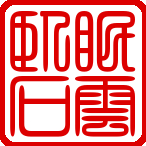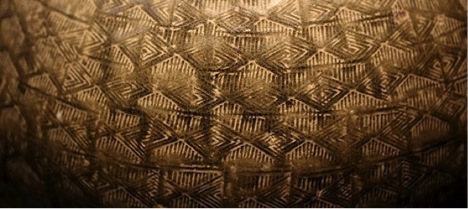The Huzhou Lei Tea Jar
An ancient jar is the earliest object identified with certainty as tea ware. The ceramic was found in a third century tomb where it was offered as funerary goods, that is to say, objects of daily use placed in the burial chamber as sacrifice to the dead. The size, shape, and features of the pottery reveal that it functioned as a storage container, while its inscription verifies that the jar was once designed to hold tea.
Made of glazed stoneware, the vessel is of fair size and well-proportioned. Generally globular in shape, the body narrows from a broad waist to a flat foot and bears a stamped geometric design known as leiwen or thunder pattern. The mouth opens from a short neck, a rounded ring that surmounts a shoulder marked by a double string band and four small lugs. The glaze is a mottled greenish brown color and covers the vessel evenly from the neck to a few broad lappets below the waist.
Under the glaze on the upper shoulder – in the space between the neck ring and the string décor – the jar bears an inscription: the character cha 茶 or tea incised neatly in clerical script. Created with a pointed stylus, the character is a combination of four straight and angled lines and four dots, a simplified rendering in eight strokes of the nine-stroke character cha 茶, meaning tea.
The jar was excavated on April 19, 1990 by the Huzhou Museum from an old tomb discovered at Luojiabang Village, Biannan Township, a site two miles southwest of Mount Wen and just west of Huzhou, Zhejiang. The unoccupied burial chamber was built of brick in the manner of the late Han dynasty and contained other well-made ceramic wares, most notably an animal-shaped ewer, a bird-headed tripod vessel, and a four-lugged jar. The styles of the architecture and the pottery indicate an age spanning from the end of the Eastern Han (25-220) to the Three Kingdoms period (220-280), circa third century of the Common Era.
Described as the archaic vessel type known as lei 罍, the jar measures 33.7 centimeters high and 36.3 centimeters wide with diameters of the mouth and base at 15.5 and 15.5 centimeters, respectively. According to speculation, the ceramic was made at the early pottery kilns of Deqing located about thirty-five miles south of Huzhou. Alternatively and more likely, the jar was manufactured at the ancient Yue kilns near present Ningbo. Both kilns made early green wares known as celadon.
The lei vessel was fully developed as a lidless storage container in both ceramic and bronze during the Shang dynasty, circa 13th-12th centuries B.C., and remained basically unchanged for millennia to this day. To close, the jar was fitted with a wooden plug, sealed with bamboo sheath and fine thick paper, and by use of the lugs was bound with cord. When sealed, the jar was resistant to air and damp. Aesthetically appealing, technically superb, uniform in shape, lightweight, and capacious, the lei was not only the stock storage container of the ages but also perfect for keeping tea.
For several reasons, the Huzhou lei is important to the art and tradition of tea. Dated to the third century, the jar is the earliest known ware expressly dedicated to tea by its manufacture and inscription. The lei is further evidence of tea in the Han and proof of the early epigraphic development and use of cha 茶 to represent the tea plant and its produce, the character recognizable even in a highly stylized and abbreviated form. Both the celadon jar and the tea it was intended to store were likely made near Huzhou, a region that formerly was known as Wucheng. Thus, the celebrated affinity of tea for celadon may be traced from at least the late Han and the Three Kingdoms period. According to the Record of Wuxing by Shan Qianzhi (died ca. 454), the marquisate of Wucheng produced a tribute tea from the imperial estates on Mount Wen in the third century, precisely contemporaneous with the Huzhou lei.
Figures
Lei Jar, 3rd century
China: Eastern Han dynasty-Three Kingdoms period
Ceramic: stoneware with applied glaze
Four lugs, stamped décor, inscribed cha 茶
H: 33.7 cm. W: 36.3 cm.; diameter: mouth 15.5 cm.; base 15.5 cm.
Huzhou Museum
Excavated from the brick tomb M1:1 at Luojiabang Village, Biannan Township, Huzhou, Zhejiang, April 19, 1990. See Zhang Bo 張柏, Zhongguo chutu ciqi quangji 中國出土瓷器全集 (Collected Ceramic Wares Excavated in China) (Beijing: Kexue chuban she, 2008), p. 26.




